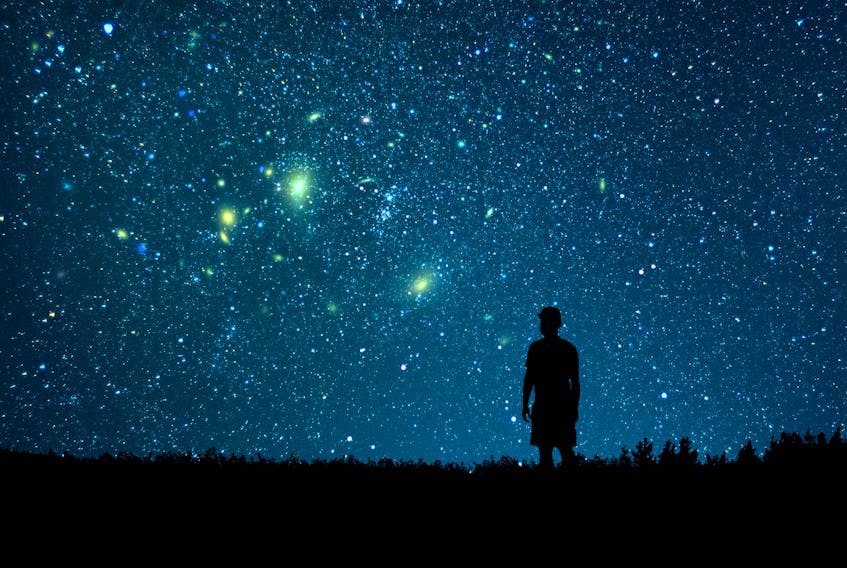Hi sky people,
I have heard many people say that it can bring wonder to go out and look at the night sky. But you can easily enhance that experience – see things in our sky that perhaps you won’t see just by looking up, but still only using your own eyes, and not any visual aid such as binoculars or a telescope. Let’s look at what you can do to enhance your vision of our night sky.
Night vision
Look in a mirror and you will see a “black” circle in the middle of your eye.

This is your pupil and it isn’t truly black, but actually clear. It is the “entrance site” for light to enter your eye and fall upon the retina – the back inside of the eye. When light touches the retina like this, this is how we see.
Now, the next part to look at in the mirror is the coloured portion of your eye. This is the iris and it is a muscle. As it contracts or relaxes, it changes the size or opening of the pupil. This allows us to control how much light enters our eye. If it’s bright and sunny on a beach, the iris closes the pupil down – to perhaps 1.5 mm. In contrast if it’s dark out, the pupil will get bigger to as much as 7 mm and let more light in. This is one of the problems in our modern world of many bright lights at night. The pupil does not open widely and we do not see well in the semi-darkness.
Pupil widening – the development of night vision takes a bit of time. Try this. Be in a brightly lighted room and go directly outdoors, if it’s dark. If you look up, you can watch the stars “blink” on, as your pupil enlarges. It can take half an hour for us to develop reasonable night vision, and three hours for maximal night vision. The motto – be patient!
You should also know that children and younger teens can get their pupil to open further than an older person and thus, potentially, to see dimmer objects. See if your son, daughter or grandchild says they can see something in the sky, and you can’t, chances are they are correct.
Averted vision
Averted vision is a little bit more difficult to get used to but it can pay dividends in terms of what we see. If we go back to the retina – the back lining of our eye, there are two types of cells there – rods and cones. The rods cover 99 per cent of the retina, while the cones cover only one per cent. Whenever we look at something directly, and see it clearly, we are pointing our one per cent of cones at that object. Now our cones allow us to see colour and gives us fine or detailed vision. On the other hand, the rods, the other 99 per cent, don’t help with colour and really gives us almost blurry vision. But, they are much more sensitive to light and therefore, see better at night. How do we use our rods, and thus our averted vision? Although the rods cover most of the back of the eye, they are most concentrated in a sort of oval around the cones and our fine vision. So, if you look a little up or down, or sideways, instead of directly at something, you will see it more clearly – at night, than if you look directly at it. You have to practise this one.
Happy Night and Averted Vision hunting
So what is in the sky this month? This is actually a fairly exciting month. As always, we will start with the planets.
In our night sky, the planets Jupiter and Saturn, which we have discussed as morning planets for the last several months, are now clearly becoming evening planets. If we look in the southeast by 10 p.m., we should see Saturn to the left and Jupiter to the right both just to the left of a famous asterism in the southern sky – The Teapot. They are both retrograding, or moving backwards against the back ground stars.
Jupiter reaches opposition July 14 and Saturn July 20. This means they are directly opposite the sun in the sky. These are the only planets in the night sky, but Jupiter and Saturn can also be seen in the morning sky a couple of hours before sunrise in the southwest.
The morning is great. Mars is brightening and enlarging. It rises a little after midnight at the beginning of July in the southeast. Venus is now appearing in the morning sky roughly in the east, and rapidly climbs higher in the sky, rising earlier and earlier.
Mercury will appear in the morning sky at approximately July 17 between east and east-northeast. It will be below and to Venus’s left.
See you next month. Good viewing.
Dr. Rolly Chiasson is your night sky guy. His column runs monthly. To comment or get in touch with him email [email protected].









